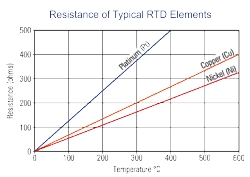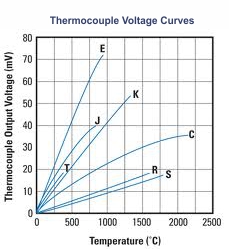RTD vs Thermocouple – Which is Best?
 Both RTDs and thermocouples are sensors used to measure heat in scales such as Fahrenheit or Centigrade. Such devices are used in a broad range of applications and settings, each with its own advantages and disadvantages.
Both RTDs and thermocouples are sensors used to measure heat in scales such as Fahrenheit or Centigrade. Such devices are used in a broad range of applications and settings, each with its own advantages and disadvantages.
Resistance Temperature Detectors (RTDs)
The electrical resistance of metals rises as the metals become hotter, and falls as heat decreases. RTDs are temperature sensors that use the changes in the electrical resistance of metals to measure the changes in the local temperature. For the readings to be interpretable, the metals used in RTDs must have electrical resistances known to people and recorded for convenient reference. As a result, copper, nickel, and platinum are all popular metals used in the construction of RTDs. The easiest way to identify an RTD is by its wire leads. RTDs most often have three wires coming out of them, two of the same color and one of a different color, usually two white wires and one red wire. They can be of other colors but these are the type we most often encounter on a turbine. RTDs can have two wires, however they are not often used in industry any longer as they are not as accurate as three wire sensors.
 Thermocouples
Thermocouples
Thermocouples are temperature sensors employing two dissimilar metals to produce a small voltage that can be read to determine the local temperature. Different combinations of metals can be used in building the thermocouples to provide different calibrations with different temperature ranges and sensor characteristics. They are classified as a “type” of thermocouple such as E, J, K, etc. The different types are made from various types of metals and are used for a wide range of temperatures. The type of thermocouple can only be identified by its lead wire color. Thermocouples always have two wires with dissimilar colors.
RTD vs Thermocouple
Because the terms encompass entire ranges of temperature sensors tailored for use under a range of conditions, it is impossible to conclude whether RTDs or thermocouples are the superior option as a whole. Instead, it is more useful to compare the performance of RTDs and thermocouples using specific qualities such as cost and temperature range so that users can choose based on the specific needs of the application.
In general, thermocouples are better than RTDs when it comes to cost, ruggedness, measurement speed, and the range of temperatures that can be measured. Most thermocouples are half the cost of RTDs. Furthermore, thermocouples are designed to be more durable and react faster to changes in temperature. However, the main selling point of thermocouples is their range. Most RTDs are limited to a maximum temperature of 1000 degrees Fahrenheit. In contrast, certain thermocouples can be used to measure up to 2700 degrees Fahrenheit.
RTDs are superior to thermocouples in that their readings are more accurate and more repeatable. Repeatable means that the same temperatures produce the same readings over multiple trials. RTDs produce more repeatable readings which are more stable, while their design ensures that RTDs continue producing stable readings longer than thermocouples. Furthermore, RTDs receive more robust signals and it is easier to calibrate RTD readings due to their design.
Conclusion
In brief, RTDs and thermocouples each have their own advantages and disadvantages. Furthermore, each make of RTDs and thermocouples possesses its own advantages and disadvantages. In general, thermocouples are cheaper, more durable, and can measure a larger range of temperatures, while RTDs produce better and more reliable measurements.
